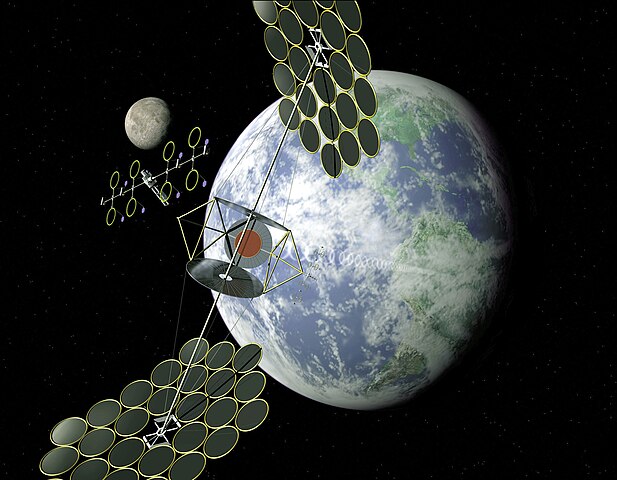
Is space based solar power possible? Yes, space based solar power is certainly possible, but there are a lot of problems that need to be overcome first.
The idea behind space based solar power is that they would have unimpeded sunlight for virtually 24 hours a day, every day. Solar power stations on Earth are always limited by the weather, the atmosphere, and, of course, the fact that half of every 24 hours is night. There is not much that can be done about the sun shining on the other half of the Earth for half of every day, but the atmosphere and the weather can be selected for. A lot of solar power stations are located in area that have very little cloud cover and a large amount of direct sunlight. They are often in deserts, which are naturally very dry and sunny. It is estimated that every square meter of Earth receives 342 watts of solar power. That is greater in some areas and lower in others, but it is a good number. Overall, it is 44 quadrillion watts and the whole power consumption of Earth for one year is only 24 terawatts. That means the Earth receives 44,000 times more power from the sun than we need for power. Unfortunately, just because the sunlight comes here, doesn’t mean we can use it. There are a whole bunch of problems. The first being that we can’t cover the entire planet in solar panels. And that is where the space based solar power idea comes from. So, is it possible, and what problems would there be?
There are two ideas idea behind space based solar power. The first is to have a satellite made up of an enormous array of solar panels. This satellite would be programmed to follow the sun, and it would also be in geosynchronous Earth orbit (GEO). That means the satellite would orbit at the same speed as the Earth rotates, keeping it directly above the same point on Earth. The satellite would be about 36,000 km out so that it could get an unobstructed view of the sun and it would beam the energy it captures down to a receiving station on the Earth as microwaves. The power would be converted to DC and supplied to the grid. The second method is to have a giant mirror that is programmed to follow the sun and direct the sunlight down onto a single point on Earth. There would be a huge array of solar panels at the point where the sunlight hits the Earth and they would convert it into power. These are the two main ideas. They are technically possible, but there are many problems that need to be overcome before it can happen. The biggest problem is that we are trying to solve the problem with modern technology, which is the only thing we can do. A lot of the problems may be solved in the future, making it more possible then than it is now.
The first problem is the enormous cost it would require. It currently costs $3,500 to get one kg of payload into space. The reusable rockets that SpaceX are developing will reduce that cost, and it may get down to a few hundred dollars, but it is not there yet. Any kind of space based solar array would weigh over 200 tons. Notwithstanding the difficulty of building such an enormous structure, the cost of getting it into space alone would be in the hundreds of billions of dollars. Then there is the cost of building it and the cost of building the receiving station on the ground. This would be an enormous amount of money and there is no guarantee it would end up being cheaper than making power using earth based solar panels.
The second problem is space junk. Anything that is flying in GEO is going to be hit constantly by pieces of space junk that are orbiting Earth. There is nothing that can be done about that. Some of them are microscopic and some of them are larger, but any space based solar panel is going to get damaged and need to be fixed.
The third problem is that it is not possible to efficiently beam power down from a satellite in space to a power station on Earth. Power is lost at both ends and in the middle. Power will be lost into the atmosphere. Current experiments show that any system would only be about 11% efficient. There is also the fact that aiming at a point on Earth would also be difficult. The receiving station would have to be the size of a city.
The fourth problem is how to keep the space solar panels working over their lifetime. They will be subjected to enormous temperature ranges, along with being hit by space debris. They will also need rockets to keep their orbit stable, which will cause strain. Then, there is the issue of what to do with the satellite when it reaches the end of its life.
There are numerous other problems, but these are some of the major ones. Nobody is saying that it is impossible, just that with current technology it would cost too much for the return it would give. It would make far more sense to put more money into improving the solar panels and the renewable energy systems we have here on Earth. Maybe one say space solar panels will be feasible and make economic sense, but not yet. And this is what I learned today.
Try these:
Sources
https://www.science.org/content/article/nasa-too-down-space-based-solar-power
https://en.wikipedia.org/wiki/Space-based_solar_power
https://spectrum.ieee.org/space-based-solar-power-2667878868
https://www.nasa.gov/wp-content/uploads/2015/03/135642main_balance_trifold21.pdf?emrc=5b9a71
https://en.wikipedia.org/wiki/Electric_energy_consumption
Image By NASA – http://science.ksc.nasa.gov/shuttle/nexgen/Nexgen_Images/solar_power_satellite_concept.jpg, Public Domain, https://commons.wikimedia.org/w/index.php?curid=16117438
